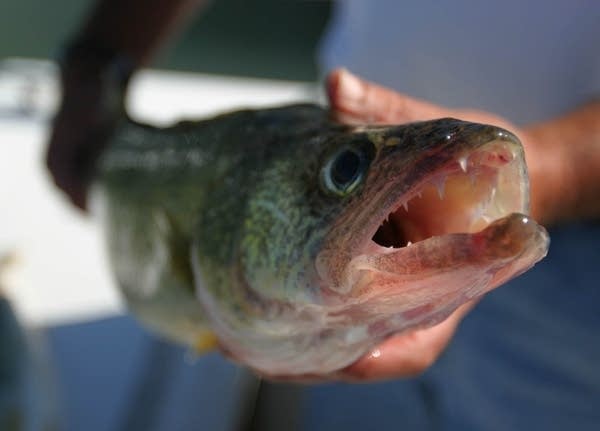Study: Walleye reproduction not affected by Miss. River chemicals

A new study finds walleye in the Mississippi River are consistently exposed to emerging contaminants such as pharmaceuticals. But the chemicals are apparently not affecting reproduction of the state's iconic sport fish.
A broad range of chemicals can cause male fish to take on female characteristics. An earlier study of bass in the Mississippi found many male bass were developing female reproductive organs.
Researchers at St. Cloud State University wanted to know if those chemicals are affecting the reproduction of walleye, as well. So they collected walleye for three years at six locations on the Mississippi River, from Bemidji to Lake Pepin.
They examined the male walleye to see if reproductive organs were feminized, and also looked for genetic changes.
Create a More Connected Minnesota
MPR News is your trusted resource for the news you need. With your support, MPR News brings accessible, courageous journalism and authentic conversation to everyone - free of paywalls and barriers. Your gift makes a difference.
"We did not see anatomical changes, and we also did not see genetic differences between these fish that we would relate to emerging contaminants," said Heikko Schoenfuss, director of the university's Aquatic Toxicology Laboratory.
The results were surprising, he said.
Because male bass in the Mississippi were feminized, Schoenfuss hypothesized something similar would happen to walleye.
"I was anticipating a stronger response in walleye than we observed," Schoenfuss said. "I was expecting ... reproductive organs would be altered, and potentially even the genetic diversity would be altered."
It's clear from the research that walleye in the Mississippi are exposed to emerging contaminants. The compounds that affect fish reproduction were found in all locations, even areas upstream of city sewage treatment plants.
The male walleye were all producing vitellogenin, a protein related to egg development in females. Finding that protein in male fish is a biological marker which shows they've been exposed to chemicals and pharmaceuticals.
But Schoenfuss said while that exposure alters the reproductive organs of bass, it does not have the same effect on walleye.
"We don't know exactly why walleye are less sensitive, apparently, to these compounds, but it is good news for walleye in the Mississippi River," he said. "It does not alleviate all of my concerns -- or many of my concerns, because we still do not understand why different species of fish act differently."
Schoenfuss said it is important for researchers to understand biological differences in sensitivity to protect the aquatic ecosystem.
That means a study of one species of fish can't be used to generalize about the effects of emerging contaminants on all fish, Schoefuss said.
Although the study is good news for walleye, it raises some critical questions about further research.
"What species do we need to look at in particular because they are so sensitive?" Schoefuss asked. "Are there sentinel species we need to study because they are the most likely ones to be hurt by these compounds? And are we looking at the right species of fish in the first place?"
Researchers around the country are trying to answer those questions.
Current studies are looking at how different amounts of contamination affect fish and how very low levels of chemicals might affect the genetic makeup of fish.
